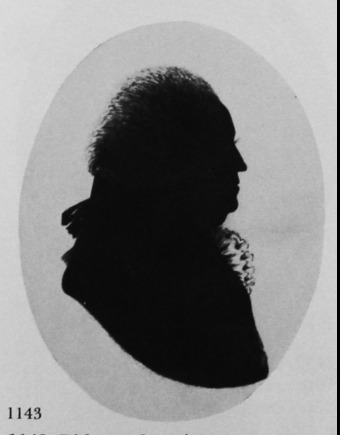Rider and Bazing (Rider, Thomas and Bazing, William) (McKechnie Section 3)
I know of two silhouettes, each of which bore an inscription or trade label giving the names of Rider (q.v.) and Bazing. One (illustrated) was formerly in the Wellesley collection; the other was seen by Mayne. The chief source of information about the partnership is Mills; Jackson (Dictionary) bas nothing to add. As the example seen by Mayne was of the usual bust-length size, but backed with gold leaf in the style of some of Rider's work, one can assume that it was painted by the artist named Rider who is discussed in a separate entry above. Apart from Mills and Mayne, I know of no authority who lists any artist named Bazing. (Bénézit lists a Basing who worked in Australia c. 1865, who may have been a descendant).
Although Mayne mentions a trade label, bearing the address 408 Strand, ‘opposite the Adelphi’, London, he does not quote the text in full. One might have learned for certain from the label whether Bazing was in fact a silhouette artist, or a painter of verre églomisé or frame-maker who collaborated with Rider. Since the illustrated silhouette is of finer quality than the silhouette known to have been painted by Rider when working independently, it is likely that it was painted by Bazing.
As I have mentioned in the entry on him, Rider may have been the son of Thomas Ryder (1746-1810) the engraver, who, as a student, worked with James Basire I. The similarity of the names Basire and Bazing, together with the connection between James Basire and Ryder, lead one to surmise that Bazing may have been a member of the Basire family. Much of the history of this family of engravers is obscure, but the male descendents of at least three generations appear to have been named James. James Basire I (1730-1802) first taught Thomas Ryder, the engraver, and then worked with him at the Shakespeare Gallery for Boydell. James Basire II (1769-1822), also a fine engraver, was at one time engraver to the Royal Society (Samuel Redgrave, A Dictionary of Artists of the English School, London, 1878). Thomas Ryder worked at the same address as James Basire I; the Basire and Ryder families of engravers were therefore certainly acquainted, and James Basire II may have been the ‘Bazing’ of the Rider and Bazing partnership. (The discovery of a silhouette signed ‘Bazing’, however, would tend to invalidate this theory).
The appearance of the illustrated example leads me to suggest that the partnership flourished c. 1792.
This profile does not show the dip at the back of the bust-line termination which is seen on work by Rider dating from after c. 1787. The termination is of the convexity/concavity type, and plunges rather low in front. Fine detailed strokes show the sitter’s hair and the formation of his shirt-frill; five regularly spaced dark patches clearly define the distance between the two layers of the frill. Since no profile of a man by Rider was available for illustration in this book, the reader cannot compare his treatment of such details as pigtail ribbons with that on the example by Rider and Bazing, but it might be noted that the ribbons on the woman’s hat shown on one illustrated silhouette by Rider show a complex treatment of light and shade, while those on the Rider and Bazing example are shown simply in plain black. As I have suggested, the piece is probably Bazing’s work.
The profile is housed in a fine oval gilt frame, with a leaf border on the inner edge, and is glazed with a very fine verre églomisé surround (quite as well executed as any which I have seen on the work of Mrs Beetham). The églomisé leaf on this border is not crowded with the black and gold lines seen, for instance, on work from the studio of John Miers. The whole piece appears to be very fine work.
Ill. 1143

Unknown man
Silhouette painted on convex glass, with verre églomisé border
c. 1792
3 ¾ x 2 ¾ in./96 x 70mm.
Frame: oval, gilt, with leaf design on inner edge
Known to have borne a label or an inscription of Rider and Bazing, this silhouette is so different from Rider’s independent work that it is probably by Bazing.
From Weymer Mills, ‘One Hundred Silhouette from the Wellesley Collection’ (1912), by courtesy of the Oxford University Press
